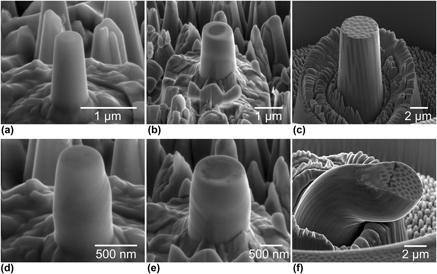Article contents
Micromechanical study on the deformation behavior of directionally solidified NiAl–Cr eutectic composites
Published online by Cambridge University Press: 14 February 2017
Abstract

The effect of Cr fibers on the deformation of directionally solidified NiAl–Cr eutectics, prepared at three different solidification speeds affecting the fiber diameter and fiber spacing, was studied at varying length scales using different micromechanical testing techniques. In situ tensile tests in a scanning electron microscope of individual Cr fibers showed high strength accompanied by ductile behavior. Comparative microcompression tests on single-phase NiAl pillars and NiAl pillars containing a single fiber showed that the pillars with the single fiber were marginally weaker than the single-phase pillars for similar pillar diameters. Composite pillars with multiple fibers exhibited an increase of 0.2% offset strength values with increasing solidification speed. Transmission electron microscopy of the composite pillars containing a single fiber after deformation revealed significant dislocation activity both in the fiber and the matrix. It is argued that the interface between the fiber and matrix acts as dislocation source promoting plastic deformation of the brittle NiAl matrix.
- Type
- Articles
- Information
- Copyright
- Copyright © Materials Research Society 2017
Footnotes
Contributing Editor: Yang-T. Cheng
References
REFERENCES
- 7
- Cited by





